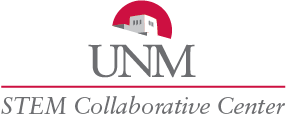STEM Collaborative Center (STCC)
The STEM Collaborative Center promotes collaboration between UNM departments, and develops STEM engagement opportunities for first and second year UNM students.
University of New Mexico-Main CampusEstablished: 2015
Profile submitted by Tim Schroeder
Vision and Goals
Mission Statement: Collaborate & Strengthen. Engage & Connect.
Collaborate & Strengthen. Collaborate with UNM STEM programs to strengthen UNM STEM education efforts.
Engage & Connect. Engage students in STEM exploration and enrichment activities. Connect students to STEM departments and support programs.
Center/Program Structure
The STEM Collaborative is funded through a five-year developmental grant from the US Department of Education for approximately $2.6M. It is housed within UNM's Department of Student Affairs and is run by staff members. We have seven full-time staff members (1.0 FTE), two graduate assistants (.5 FTE), and three student employees (.25 to .5 FTE). There are no faculty or research positions within the grant, but we do partner with other faculty from various departments and organizations.
Description of Programming
The STCC is focused on supporting and bolstering existing STEM programs at UNM and in the New Mexico community, as well as creating new partnerships that will last past the end of the grant's close. We work to get students connected with faculty and industry representatives early in their college careers. We have two main areas of programming: STEM University and the STEM Communication Network. STEM University is a collection of free activities related to STEM. These events help connect students with careers and internships; scientists, engineers, researchers, faculty members and peers; emerging technologies; cutting-edge research; and leadership and advocacy in STEM. STEM University events are offered in the following formats:
- Workshops are short sessions that introduce students to opportunities or basic concepts, or provide an introductory glimpse into research or technology. Workshops range in length from 30 minutes to 3 hours.
- Conference sessions are workshops that are offered as part of student conferences at UNM. In these sessions, students may develop presentations, learn about navigating an academic or professional conference, and network with other researchers. Conference sessions generally last 50 minutes and the workshops can range from one to several hours.
- STEM University trips introduce students to site-based research, internships, career pathways and emerging technologies. Trips range from half-day to four days in length.
- Projects provide students the opportunity to participate extensively in research, advocacy, leadership, professional development or emerging technology. Projects often require substantial time commitments, ranging from 8 to 36 hours over the course of a semester.
- Mentorships connect students with scientists, engineers or other STEM professionals. Mentorships generally require a commitment of between 10 and 24 hours over the course of a semester. An example of this program is the UNM and Air Force Research Lab Mentorship program that began in fall 2015.
- Civic engagements provide students the opportunity to improve chosen STEM professions and to strengthen communities. An example of a civic engagement project is helping the student chapter of Society for Advancement of Chicanos and Native Americans in Science lead science experiments with local K-12 school groups.
The STEM Student Communication Network Resources and Services is a program designed to help UNM organizations navigate through many of the most active communication and advertising channels for STEM-interested students here at UNM. There is an extensive Handbook for public and free use that lists all marketing venues and guidelines on campus. It also includes STEM-focused listservs, social media, and student organization contacts.
The Handbook is divided into two sections: Networking Resources and STCC Networking Services. The Networking Resources section lists various methods for reaching UNM's STEM communities, including campus bulletin boards, listservs, and more. The STCC Networking Services section details the ways in which the STCC will assist with actual networking and marketing across campus.
Successes and Impacts
As we are in Year One of a five year grant, we are still gathering data on impact overall. We do know that over 400 undergraduates were involved in our programs in some capacity in Year One. As a title V grant, our focus is on especially serving Hispanic, low-income, and/or first-generation students. We are working now on pulling that data and should have it available shortly. Our Annual Reports which contain this info will be hosted on our website at: stem.unm.edu
Elements Contributing to Success
The success of our center so far is in part due to the combined efforts of our partners, and especially the student organizations. At UNM, many departments suffer from silo effects where effective and unique programs are sequestered for a variety of reasons (staff shortages prohibit expansion or extensive advertising, for example). The openness and willingness to collaborate with us to put on wonderful activities and opportunities has been invaluable.



![[creative commons]](/images/creativecommons_16.png)